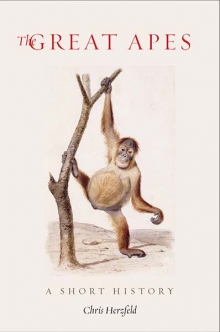The Great Apes: A Short History by Chris Herzfeld
/The Great Apes: A Short History
by Chris Herzfeld
translated from the French by Kevin Frey
Yale University Press, 2017
Christ Herzfeld's Petite histoire des grands singes appeared originally in 2012 and now has an English-language translation from Yale University Press by Kevin Frey that ably captures both Herzfeld's sweeping viewpoint and his sharply inquisitive tone; the book presents readers with a fast-paced and engaged history of humanity's historical and scientific encounters with gorillas, orangutans, bonobos, and chimpanzees and broadens whenever it can to larger issues of ethology and primatology.
This American edition of Herzfeld's book opens with an introduction by the great Jane Goodall, which can only do so much to mitigate the shock of the first line by Herzfeld himself: “We share a long history with primates.”
A sentence so staggeringly bumptious might well be a warning, but it turns out that whatever Herzfeld's reason might have been for writing it, the remainder of the book is nothing like it. Instead, our author patiently and succinctly sketches the parameters of an enormous subject. We move in quick, expertly-detailed stages from great apes encountered by explorers and pathbreaking scientists in the wild to the long, grindingly miserable enslavement of apes by their human kin – and enslavement, as Herzfeld points out with a portion too much dispassion, that continued well into the present day and still goes on:
In 2006, 62,315 apes and monkeys (including approximately 1,500 chimpanzees) were still being used for medical and behavioral experiments in the United States. In 2010, the European Community banned all medical research using great apes, although 10,000 monkeys (out of 100,000 tested each year worldwide) are still used for medical research in Europe. The same year, the NIH asked a commission of experts at the Institute of Medicine for a report on the necessity of pursuing such research. These experts estimated that the majority of their studies were no longer necessary.
The obscene sadism of those “medical and behavioral experiments” is as black as the bottom of a well. It cannot possibly be Herzfeld's main subject, or it would swamp his thin book. Those great apes were strapped to tables and vivisected for the amusement of audiences; they were sledgehammered in the head, blinded with fire, starved over long months (and often starved to death out of simple neglect), and infected with every ailment humans could transport from laboratories into their veins (human scientists looked into the faces of year-old chimpanzees and injected them with the AIDS virus). Humans drug parent monkeys and apes into deathlike stupor in order to watch the horrified panic it evokes in their offspring. Humans have been pointlessly torturing, sickening, and murdering great apes for the entire time those behaviors have been possible. And since they still are (all Earth's great ape populations are currently being decimated by hunting and habitat loss; it's incredibly unlikely than species will still exist in the wild by the end of this century), there's necessarily an elegiac tone to Herzfeld's book.
Great apes like the famous Washoe have demonstrated an aptitude for learning human-devised languages; studies of ape societies in the wild routinely show the whole trite roster of scientific check-points for species worth: tool-making, improvisation, the passing on of learned information to the next generation, etc. Herzfeld compresses huge amounts of this research into only two hundred pages, complete with a collection of compelling illustrations, and he keeps the broader picture steadily in mind:
These great apes are not, however, split between two “cultures,” oscillating between one and the other. This concept, revealing a dualist way of thinking and requiring a radical separation between a human culture and a primate nature, is inadequate. The fact of being ape or human does not go back to a monolithic state that can be encompassed in a definitive characterization.
The Great Apes will work as an excellent introduction to the subject at a time when the subject is beginning its final flickering out of present, living existence. Curious readers will be encouraged to read more – and maybe go on to change the picture it paints.
Steve Donoghue was a founding editor of Open Letters Monthly. His book criticism has appeared in the Boston Globe, the Wall Street Journal, and the American Conservative. He writes regularly for the National, the Washington Post, the Vineyard Gazette, and the Christian Science Monitor. His website is http://www.stevedonoghue.com.
